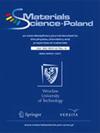复合树脂与新型杂化硅酸钙水泥的剪切结合强度及界面质量分析
IF 1.1
4区 材料科学
Q3 Engineering
引用次数: 0
摘要
杂化硅酸钙胶结剂(HCSC)是第四代新型生物活性材料,主要应用于牙髓封盖剂和间接封盖衬垫。目的是分析在相同条件下复合修复材料与新型生物活性材料和其他杂化胶结物之间的剪切粘结强度和界面质量。使用的复合材料:TheraCal和新型复合生物材料BioCal-Cap。在这项研究中,只使用了一种粘合剂系统(Scotchbond 3M, St. Paul, MN, US)和树脂基复合材料(Filtek Ultimate 3M, USA)。为此,我们制作了60个模具,分为4组。其中一半填充了TheraCal,另外30个填充了BioCal-Cap。研究了硅酸钙胶结物与复合材料的剪切粘结强度。采用Mann-Whitney检验和Wilcoxon sign Ranks检验对结果进行统计分析。在两种材料中,在立即和延迟放置复合材料后,结果没有统计学上的显着差异。然而,在这两种情况下,样品的抗剪强度都有轻微增加的趋势,这推迟了修复材料的应用。据报道,与TheraCal的抗剪强度(13.71 - 15.58 MPa)相比,新型杂化材料BioCal-Cap在两个时间段内都具有更高的抗剪强度值(18.06 - 20.25 MPa)。数据清楚地表明,复合材料放置时间不影响各观察组的剪切粘结强度。在立即放置复合材料后,中位数偏移更高,这支持了新型杂化材料BioCal-Cap的一步处理方法,而TheraCal LC则表现出相反的趋势。两种杂化水泥的胶结层均均匀,结构合理,不存在微裂缝和缝隙,不同恢复时间的胶结层厚度不同。本文章由计算机程序翻译,如有差异,请以英文原文为准。
Analysis of Shear Bond Strength and the Quality of the Interface Between Composite Resin and Novel Hybrid Calcium Silicate Cements
Hybrid calcium silicate cements (HCSC) are new bioactive materials of the fourth generation with the main application as pulp capping agents and/or as liners in indirect pulp capping. The aim is to analyze the shear bond strength and the quality of the interface between a composite restorative material and a new bioactive material and other hybrid cements at the same conditions. The used pulp-capping hybrid materials: TheraCal and the new hybrid biomaterial BioCal-Cap. In this study only one type of adhesive system (Scotchbond 3M, St. Paul, MN, US) and resin-based composites (Filtek Ultimate 3M, USA) were used. For this purpose, 60 molds were prepared and divided into 4 groups. Half of them were filled with TheraCal and the other 30 with BioCal-Cap. The shear bond strength between calcium-silicate cements and the composite material was investigated. Mann-Whitney test and Wilcoxon Signed Ranks Test were used for statistical analysis of the results. In both of the materials there was no statistically significant difference in the results after the immediate and postponed placement of the composite material. Nevertheless, in both of them there was a tendency for a slight increase in shear strength in the samples which delayed the application of the restorative material. The novel hybrid material BioCal-Cap was reported to have higher shear strength values (18.06 – 20.25 MPa) at both time periods in comparison to the values for TheraCal (13.71 – 15.58 MPa). The data clearly showed that the time of the composite material placement did not affect the shear bond strength in each of the observed groups. The median value was shifted higher after the immediate composite placement, which supported one-step treatment approach to the novel hybrid material BioCal-Cap, while the TheraCal LC exhibited the opposite tendency. The adhesive layers in both hybrid cements were homogeneous, properly structured, without the presence of microcracks and gaps, and had different thicknesses at different recovery times.
求助全文
通过发布文献求助,成功后即可免费获取论文全文。
去求助
来源期刊

Materials Science-Poland
工程技术-材料科学:综合
CiteScore
1.70
自引率
18.20%
发文量
0
审稿时长
6.2 months
期刊介绍:
Material Sciences-Poland is an interdisciplinary journal devoted to experimental research into results on the relationships between structure, processing, properties, technology, and uses of materials. Original research articles and review can be only submitted.
 求助内容:
求助内容: 应助结果提醒方式:
应助结果提醒方式:


